Implicit biases involve associations outside conscious awareness that lead to a negative evaluation of a person on the basis of irrelevant characteristics such as race or gender” (Hurst & FitzGerald, 2017).
Researchers claim that this problem is based upon the subconscious conclusions people make from their previous observations, even if they would never say them out loud. Recently, I have run into a series of articles on the examination of implicit racial bias in the modern US healthcare system. For this reason, I decided to dwell upon this topic and find some precedents in support of this idea. The purpose of this presentation is to examine the demonstration of implicit racial bias in the US healthcare system as well as to provide some case study examples on the topic.
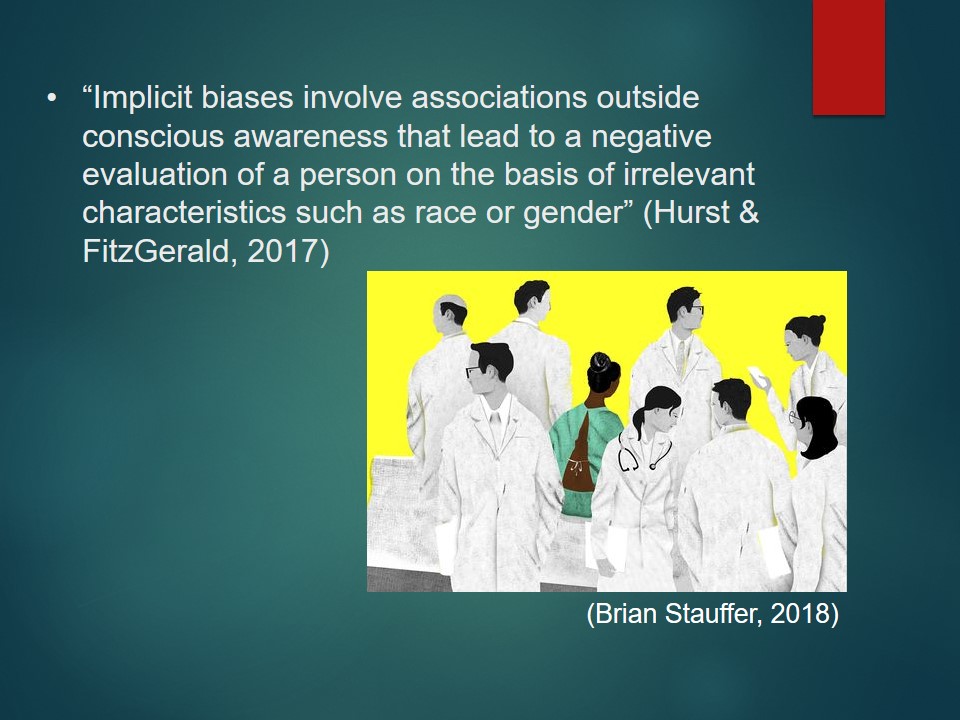
Implicit bias relevance
- Topic discussion on various TV shows / educational platforms.
- “Black community don’t know postpartum” (NPR, 2019).
Many people claim that the study of healthcare access inequity in terms of medical anthropology is no longer relevant due to the fact that it is nowadays equal regardless of all social affiliation. However, there are still a lot of researchers who examine the topic of biased patient-doctor relationship even though the issue is not as evident as previously. The question of implicit racial prejudice is also discussed on popular late-night shows such as Late Week Tonight with John Oliver and popular educational platforms such as TEDx. John Oliver, a popular TV host, devoted a part of his night show episode to the discussion of the issue of sex and race in the context of the modern healthcare system. After watching this episode, I decided to do personal research in order to find proof of the implicit bias existence.
It did not take a long time to find articles and news about racial prejudice in the medical sphere. The first piece of news, presented by National Public Radio, dwelled upon the idea that according to the statistics, African-American women are more likely to suffer from postpartum depression. However, they are afraid to publicly confess that something bothers them because both society and medical representatives believe that African-American women are stronger and should not be influenced by such things as depression. Moreover, the women themselves are put under such an implicit social pressure that they feel they do not have the right to become vulnerable. Some of the interviewees even mentioned that they did not want to admit the fact of having a postpartum because they thought their children might be taken away from them.
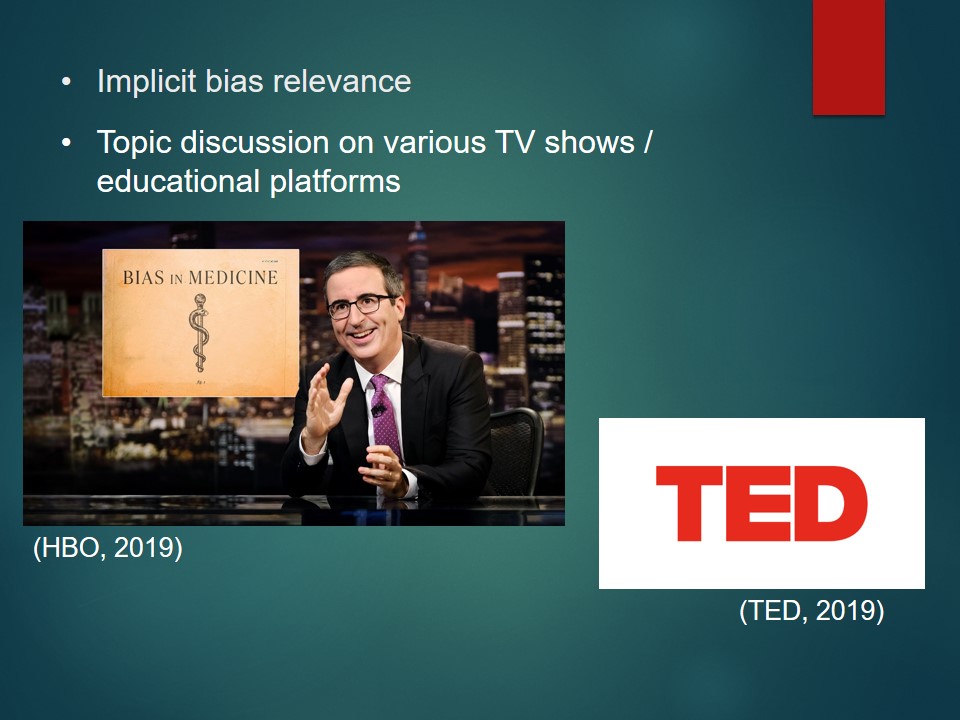
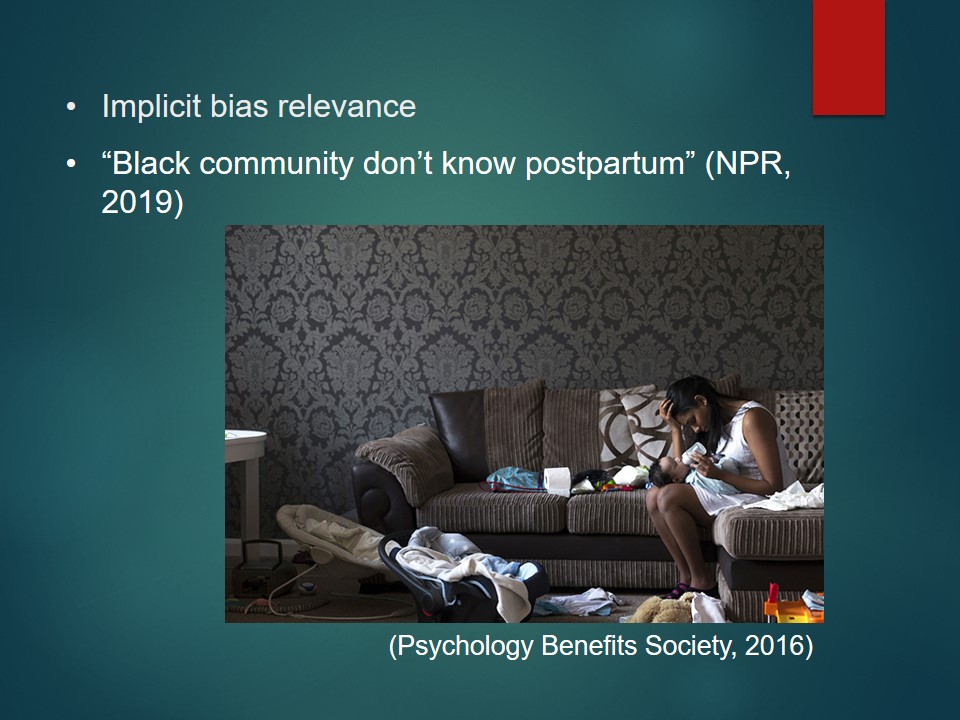
Racial implicit bias concerns doctors as well
Some African American doctors experience double-takes when they first meet patients:
- “I notice the look on their face when I first meet them that says, ‘this isn’t who I was expecting to see’” (Medical Economics, 2019).
At first, it may seem that racial bias concerns mostly patients and people’s assumptions about their lifestyle, which may cause a certain health condition. However, a recent article in Medical Economics stated that doctors could experience such an attitude too. For example, James Ellzy, a family physician, claims that he often notices the dissonance his patients experience when they first meet him. Although implicit bias is not as dangerous for society as the actual discrimination, it may cause a lot of inconvenience in terms of the patient-doctor relationship. For that reason, I decided to create a case study from both the patient’s and doctor’s perspective to find out how people should act once they experience implicit prejudice towards others.
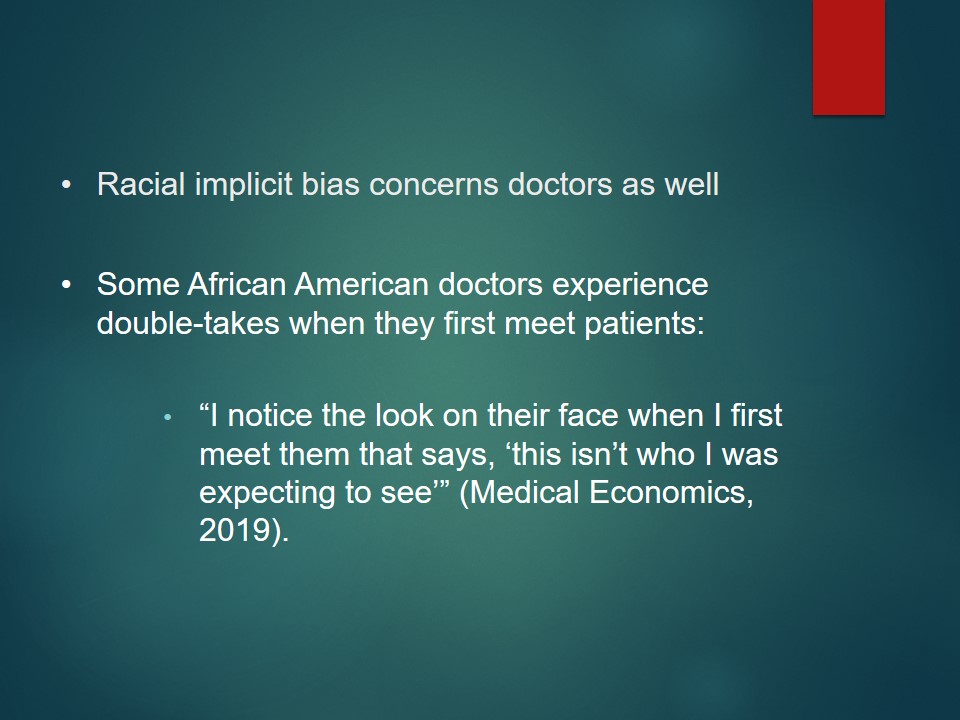
Case Study Structure
- The introduction of the case participants.
- The case brief scenery.
- The definition of a biases present in the case.
- Biases examination:
- define the patterns of participants’ behavior.
- define how to act in a real situation.
The structure of the case study consists of several parts. First of all, we should provide the recipient with all the details about the case, including the healthcare establishment and brief background information about the case participants. Then, we should single out the issue a case study is going to solve. In terms of this presentation, the main problem is the experience of implicit bias towards either doctor or patient. Once all the study details are provided, students should define how the given case is correlated with the main idea of the presentation. Then, finally, they should examine the behavior of case participants and, with the help of critical analysis, single out the best way of behavior in such real-life situations.

Case Study Scenario
John
- 28 years old;
- Male;
- Single;
- African-American, born and raised in the US;
- Freelance web-designer;
- Complains of severe headaches.
John is a 28-year-old African-American single male, born and raised in the US. He works as a freelance web-designer and, thus, has a rather sedentary lifestyle. Recently, John started noticing that his headache was becoming more and more severe with each day, so he decided to visit a physician. John has recently moved to the city from his hometown, and he has not been to the hospital yet. He made an appointment in the state healthcare facility, and his physician turned out to be Katherine, a 40-year-old white female. During the first appointment, Katherine did not take any interest in John’s lifestyle details. Instead, she appointed a series of tests and inquired about the patient’s attitude towards alcohol and other substances, which could potentially damage the brain.
Katherine
- 40 years old;
- White female;
- Shows no interest of the patient’s lifestyle.
Kevin
- 37 years old;
- White male;
- Gets to know the patient, examines his lifestyle.
The further examination showed that John was suffering from migraines, which appeared due to constant stress and the time spent in front of the computer screen. He was prescribed a series of medicine, and he was advised to take a few days off for the medicine to take effect faster. For a few months, the headache was gone, and John came back to work overload and constant stress. The migraine eventually started once more, and he needed to see a doctor. However, John decided to see another specialist who appeared to be a 37-year-old white male, Kevin. Kevin made a detailed patient’s examination, figured out the information about his daily routine and work schedules. After the check-up, he appointed an exhaustive treatment plan regarding all the details of John’s lifestyle. He also explained John the implications that may arise in case of treatment ignorance. After that, John took his health conditions seriously, and his migraine did not bother him for a long time.
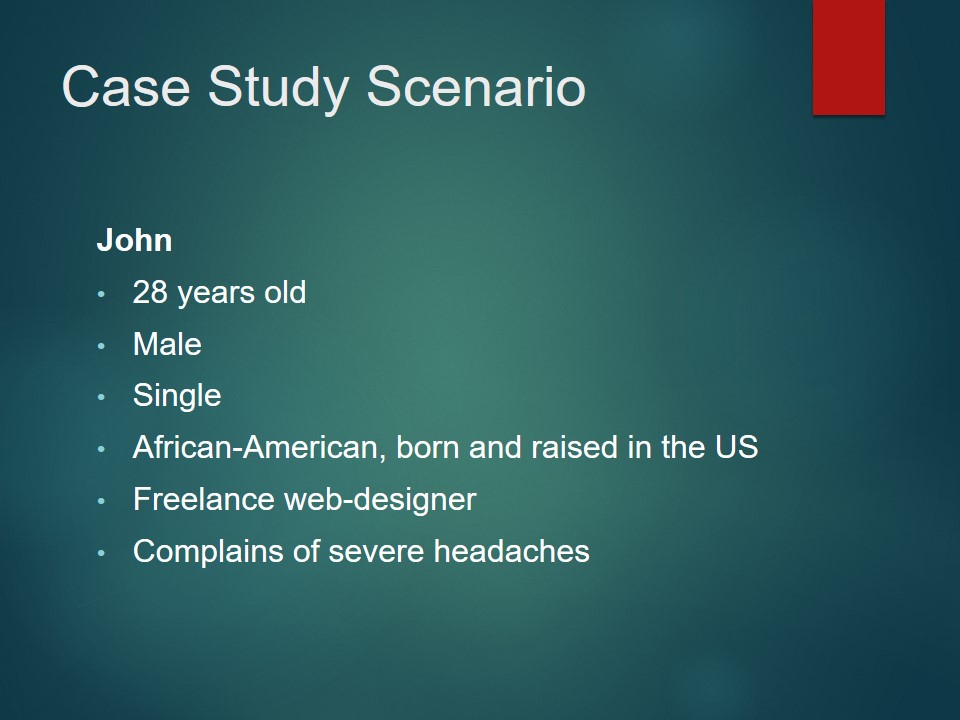
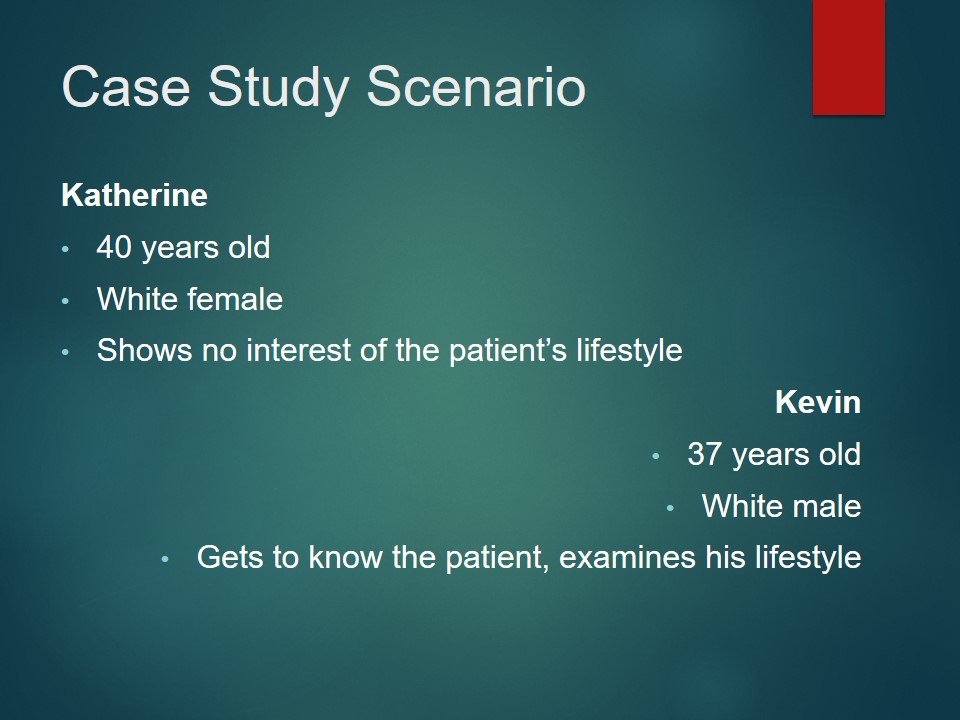
Case Study Analysis
“If doctor views the patient simply as a black woman, the possibility that the doctor’s implicit bias will be activated is much greater than if she’s seen as Mrs. Brown, a retired school teacher and mother of four children” (Medical Economics, 2019).
Being provided with all the details of the case study, we may now dwell upon the analysis of its constituents. First of all, the study should be analyzed separately in terms of John’s interaction with both doctors. The first analysis block will concern Katherine’s attitude towards the patients. Although there was no open racism during the appointment, it was evident the doctor was subconsciously influenced by some generally accepted implicit racial bias. In such a way, the doctor perceives the patient as a representative of a particular social group instead of treating him as an individual. In this case, a doctor needs to get to know his patient better rather than make assumptions based on previous experience or generally accepted beliefs. As John did not have proper communication with the physician, he decided to ask for help from other specialists with whom he would feel comfortable.
“Most educational interventions designed to reduce implicit bias appear to use a two-step approach that includes (a) making the students aware of their implicit biases, and (b) providing instruction on strategies they can use to either reduce the activation of implicit associations, or control how those associations influence judgment and behavior” (Zestcott, Blair, & Stone(2016))
Another analysis block concerning Kevin’s attitude towards the patient is the answer to the question of how Katherine should have acted in this situation. Instead of being influenced by own prejudice, he figured out the facts about John that made him an individual. According to specialists, in order to learn how to perform such an attitude towards patients, doctors should become aware that they have an implicit bias in the first place. With this knowledge, they can already control their thoughts and eradicate or ignore them while interacting with the patient.

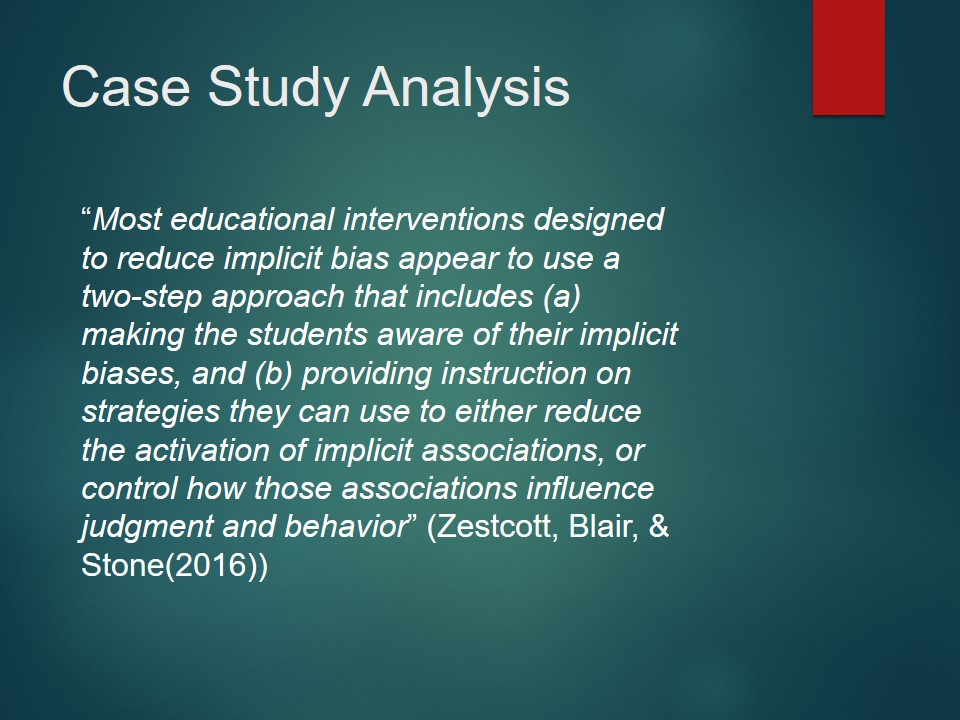
Case Study Relevance
- Connection between implicit racial bias and medical anthropology.
- Overall tendency of prejudice eradication.
- Tolerance and education interrelations.
The case study provided above is closely connected to the notion of medical anthropology. As the medical anthropology deals with the interrelation of medicine and its cultural aspects of implementation, community culture and community relations are also relevant for the study (Baer, & Singer, 2012). Implicit racial bias is a phenomenon that concerns even culturally aware US citizens. The research is also extremely relevant in terms of today’s society because showing no prejudice towards others is now an indicator of people’s awareness and education. Applied medical anthropology, thus, should pay more attention to this issue. Even though implicit racial bias is something integrated into our minds and cannot be eradicated, people should be aware of its presence so they can accept having bias and not let it control their behavior.
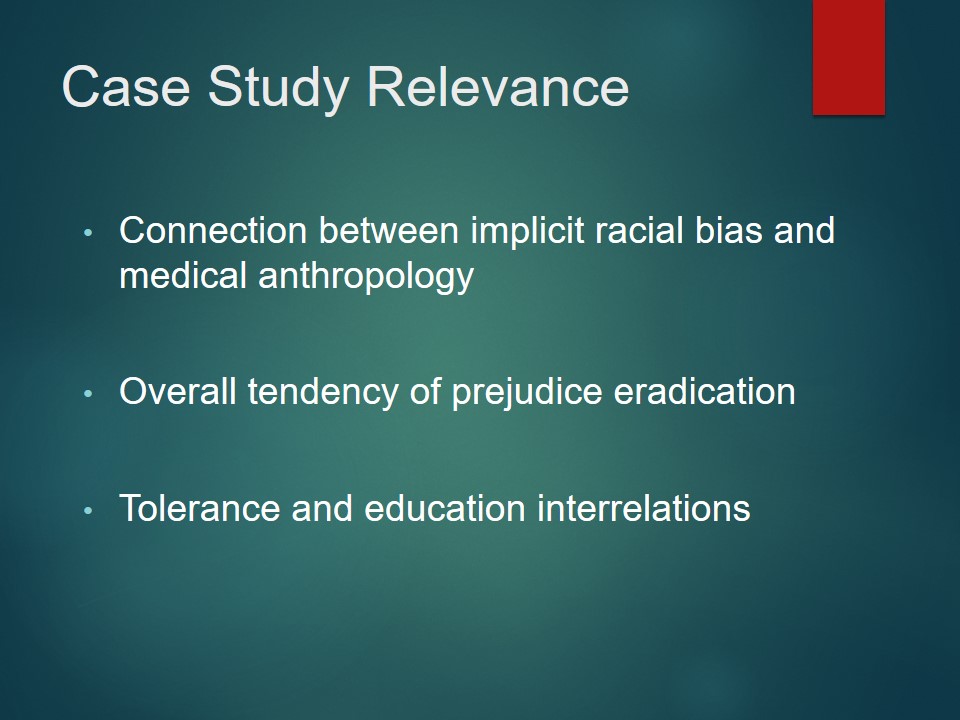
Conclusions
- Implicit bias is a common current issue.
- Implicit racial bias does not always have a negative connotation.
- Prejudiced people are deprived of personality.
- Both doctors and patients should learn to identify bias.
To sum everything up, implicit bias in medicine is the feeling of prejudice or stereotypical assumptions people make towards both doctors and patients according to their gender, race, or appearance. Implicit racial bias is a common issue in the context of US healthcare systems. Although these race-based assumptions are not always harmful, they nevertheless deprive people of their individuality and judge them from the whole racial group’s perspective. Hence, it can potentially damage the quality of healthcare provided. In order not to let this issue deteriorate the overall medical system, both patients and doctors should we aware of its existence. They would then pay attention to such implicit prejudice in case it starts to subconsciously make decisions instead of them.
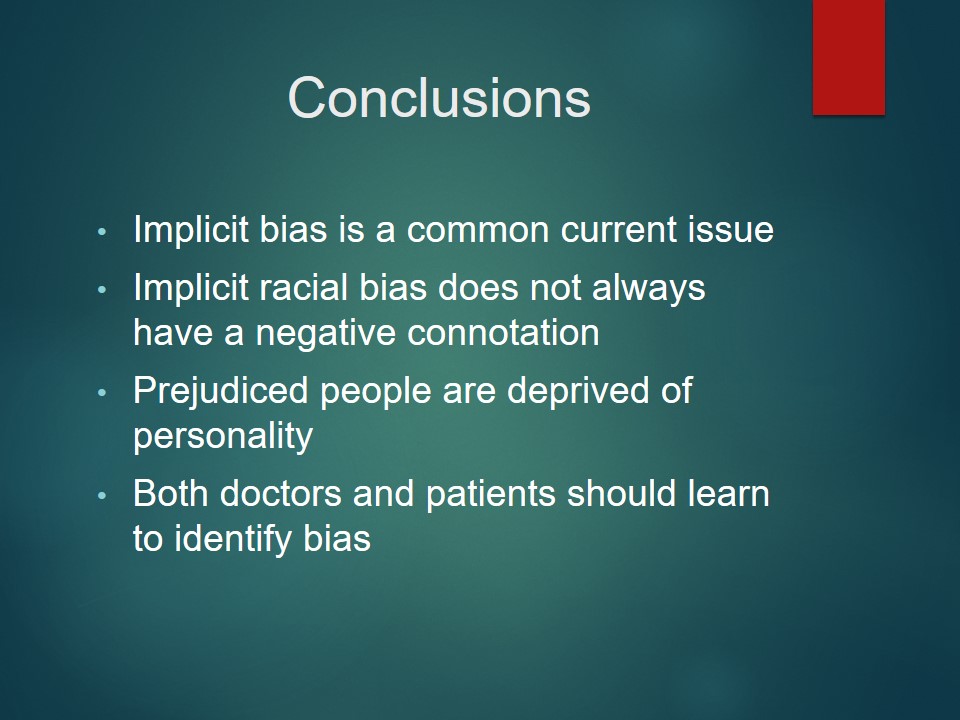
References
Black mothers get less treatment for their postpartum depression. (2019). Web.
Fitzgerald, C., & Hurst, S. (2017). Implicit bias in healthcare professionals: A systematic review. BMC Medical Ethics, 18(19).
How implicit bias harms patient care. (2019). Web.
Last Week Tonight with John Oliver: Bias in Medicine. (2019). Web.
Singer, M., & Baer, H. (2012). Introducing medical anthropology: A discipline in action, 2nd edition. Lanham, Maryland: AltaMira Press.
Zestcott, C. A., Blair, I. V., & Stone, J. (2016). Examining the presence, consequences, and reduction of implicit bias in health care: A narrative review. Group Processes & Intergroup Relations, 19(4), 528–542.